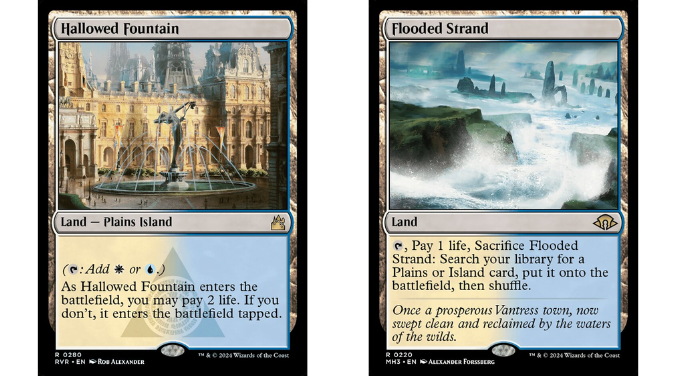Magic is a very popular game, so it’s no surprise that the game is always getting new players. In fact, the potential for new players might be at its highest ever as Universes Beyond sets have become commonplace. Whatever you may think about those types of sets, which are based on non-Magic intellectual properties, it has to be acknowledged that they bring in new players who are interested in one IP in particular.
So, if you’re one of those new players, perhaps drawn to this amazing game as a result of the upcoming Final Fantasy set, this article is for you! In it, I’ll break down the various Magic formats, so you can get a feel for the different ways we play this amazing game.
CONSTRUCTED VS. LIMITED
Magic formats can be divided into two main categories – Constructed and Limited.
Constructed formats are where you build a deck from among the cards you own and you play with that deck. Constructed formats are divided based on what sets of cards are legal in them. To play these formats, you have to have already constructed a deck that meets a format’s specific deck building rules.
Limited formats get their name because they are built from a much more limited pool of cards. Unlike constructed, you don’t build a deck before you play Limited. Rather, you build a deck as part of these formats. You do this by opening up some booster packs (usually all from the same set) and building a deck out of only those cards, and that’s what all of your opponents do too.
Let’s start with a look at Magic’s constructed formats. We’ll begin with the constructed formats with the smallest card pools and expand from there.
CONSTRUCTED FORMATS
Most of Magic’s constructed formats (with one big exception, but I’ll get to that later) require a 60-card minimum and allow a maximum of 4 copies of non-basic lands per deck. Constructed formats are largely divided based on what sets are legal in them. Magic has been around since 1993, so this type of division helps create multiple formats that are very different from one another.
Constructed formats also have a Banned List, which means that in order to meet a format’s deck building requirements, you’re going to have to make sure you aren’t playing any of the cards that are on those lists.
STANDARD
The list above contains the sets that are legal in Standard as of April 2025. Final Fantasy will be joining the list upon its release in June. In the Fall, the bottom four sets will leave the format.
This is the constructed format with the smallest card pool. The sets from the last few years are legal in Standard. For example, every Standard-release set that came out starting with Dominaria United (2022) is legal. This is currently the only “rotating” format, which means that older sets leave this format periodically. Once a year in the Fall, the 4 oldest sets in the rotation leave the format.
This format might be for you if: You want to experience constructed for the first time. This is the 60-card constructed format you are most likely to encounter as it has a much lower barrier for entry than the other formats, which contain increasingly older and older cards.
COMMANDER
This is Magic’s most popular format. It differs from the other constructed formats in several ways. First, the minimum number of cards for a Commander deck is 100 cards. Second, all cards are limited to one per deck. Third, while Commander can be played 1v1 as is typical for the other Commander formats, it is much more frequently played with 4 players.
While those differences are huge, perhaps the biggest difference is that each Commander deck has a “Commander” – a legendary creature that begins the game in the “Command Zone,” meaning you can cast it from there. The Commander you choose determines your deck’s “Color Identity,” which means you can only run cards that match the colors of your Commander.
This format might be for you if: You have lots of friends you’d like to play Magic with all at once.
PIONEER
Pioneer contains all set from Return to Ravnica (2012) forward. As with all non-rotating formats, new cards get added to this format with every new release, and sets never rotate out of the format either. In other words, Pioneer is always expanding. Generally speaking, non-rotating formats get more and more powerful the more cards that are legal in them. So you can usually expect a Pioneer deck to be stronger than a Standard deck.
This format might be for you if: You’d like your Standard deck to remain legal even after rotation.
MODERN
Modern contains all sets dating back to Eighth Edition (2003). One of the defining elements of this format is the presence of both fetch lands and shocklands. Fetch lands can be sacrificed to search up lands with specific types, and Shock lands have two land types and can enter untapped if you pay 2 life
This combination gives these decks very powerful and consistent mana-bases, to go along with a card pool that also happens to be significantly more powerful than Standard or Pioneer. In addition to the usual Standard-release sets becoming legal in the format, Modern Horizons sets are also printed periodically with cards intended to shake up this format.
This format might be for you if: You want access to lots of Magic cards, but having access to all of them is a little too overwhelming.
THE “ETERNAL” FORMATS: LEGACY & VINTAGE
Legacy & Vintage are called the “Eternal” formats because they contain every single Magic set ever released, going all the way back to 1993. The difference between the two of them comes down to each format’s respective Banned & Restricted list. Legacy has tons of cards that are banned, while Vintage has very few. Instead, the format uses a “Restricted” List, which means there are many cards that are limited to one per deck.
As with Modern, one of the defining elements of both of the Eternal Formats comes as a result of its lands. Obviously, Legacy & Vintage have access to every land ever printed, including the original dual lands. These are like Shock Lands, except they always enter untapped and never do any damage to you.
Meanwhile, the most defining element of Vintage is the presence of the Power 9. 9 insanely strong cards released in Magic’s very first set that are restricted in Vintage and not legal in any other formats.
Legacy might be for you if: You want to experience powerful Magic, but nothing that is too overpowered.
Vintage might be for you if: You’re independently wealthy and you want to experience the most powerful Magic ever played.
LIMITED FORMATS
There are only two Limited formats that you’re likely to encounter – Draft and Sealed. For both of these formats your deck has to have a minimum of 40 cards.
SEALED
.
In sealed, you and your competitors open up six booster packs. Using only those cards and as many basic lands as you want, you build a 40-card deck. While this isn’t a format most Magic players play all the time, it is the format that is used at prereleases. It’s a great way to experience a new set and all it has to offer.
This format might be for you if: You like solving problems with a limited number of tools.
DRAFT
Draft is a little more complicated than Sealed. Instead of each player individually opening packs and building a deck right away, a draft involves 8 players sitting together at a table. Each of those players opens up a booster pack, picks a card, and then passes it to the right. You do this with three booster packs until all of the cards are gone. For the second pack, you pass to your left instead of to your right.
You can think of it like a draft in fantasy (and real-world) sports, in that each player is trying to pick the strongest card for their deck in each pack. After the draft, each player builds a 40-card deck using the cards they drafted, and then the players who drafted together play against one another.
This format might be for you if: You like making decisions quickly and getting to play a large role in what cards end up in your pool.
END STEP
Those are the primary ways in which you can play Magic! I hope it helped as an introduction to all the ways we can play this amazing game.
Are you new to Magic and want more content teaching you about the game? Sign-up for our emails and we’ll make sure you’re in the know about new content!

Jacob has been playing Magic for the better part of 24 years, and he especially loves playing Magic’s Limited formats. He also holds a PhD in history from the University of Oklahoma. In 2015, he started his YouTube channel, “Nizzahon Magic,” where he combines his interests with many videos covering Magic’s competitive history. When he’s not playing Magic or making Magic content, he can be found teaching college-level history courses or caring for a menagerie of pets with his wife.


